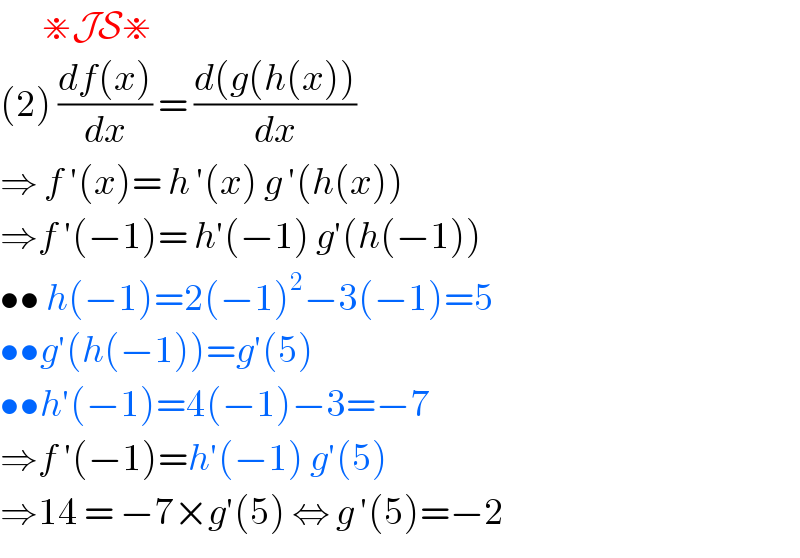Question Number 107470 by bemath last updated on 11/Aug/20

$$\:\:\:\:\:\:\:\:\circlearrowleft\mathcal{B}{e}\mathcal{M}{ath}\circlearrowright \\ $$$$\left(\mathrm{1}\right)\left(\mathrm{1}+\mathrm{tan}\:\mathrm{3}°\right)\left(\mathrm{1}+\mathrm{tan}\:\mathrm{4}°\right)\left(\mathrm{1}+\mathrm{tan}\:\mathrm{41}°\right)\left(\mathrm{1}+\mathrm{tan}\:\mathrm{42}°\right)=? \\ $$$$\left(\mathrm{2}\right){f}\left({x}\right)={g}\left({h}\left({x}\right)\right);\:{h}\left({x}\right)=\mathrm{2}{x}^{\mathrm{2}} −\mathrm{3}{x}. \\ $$$${If}\:{f}\:'\left(−\mathrm{1}\right)=\mathrm{14}\:{then}\:{g}\:'\left(\mathrm{5}\right)=? \\ $$
Answered by john santu last updated on 11/Aug/20

$$\:\:\:\:\:\:\:\divideontimes\mathcal{JS}\divideontimes \\ $$$$\left(\mathrm{2}\right)\:\frac{{df}\left({x}\right)}{{dx}}\:=\:\frac{{d}\left({g}\left({h}\left({x}\right)\right)\right.}{{dx}} \\ $$$$\Rightarrow\:{f}\:'\left({x}\right)=\:{h}\:'\left({x}\right)\:{g}\:'\left({h}\left({x}\right)\right) \\ $$$$\Rightarrow{f}\:'\left(−\mathrm{1}\right)=\:{h}'\left(−\mathrm{1}\right)\:{g}'\left({h}\left(−\mathrm{1}\right)\right) \\ $$$$\bullet\bullet\:{h}\left(−\mathrm{1}\right)=\mathrm{2}\left(−\mathrm{1}\right)^{\mathrm{2}} −\mathrm{3}\left(−\mathrm{1}\right)=\mathrm{5} \\ $$$$\bullet\bullet{g}'\left({h}\left(−\mathrm{1}\right)\right)={g}'\left(\mathrm{5}\right) \\ $$$$\bullet\bullet{h}'\left(−\mathrm{1}\right)=\mathrm{4}\left(−\mathrm{1}\right)−\mathrm{3}=−\mathrm{7} \\ $$$$\Rightarrow{f}\:'\left(−\mathrm{1}\right)={h}'\left(−\mathrm{1}\right)\:{g}'\left(\mathrm{5}\right) \\ $$$$\Rightarrow\mathrm{14}\:=\:−\mathrm{7}×{g}'\left(\mathrm{5}\right)\:\Leftrightarrow\:{g}\:'\left(\mathrm{5}\right)=−\mathrm{2} \\ $$
Answered by $@y@m last updated on 11/Aug/20

$$\left(\mathrm{1}+\mathrm{tan}\:\mathrm{3}\right)\left(\mathrm{1}+\mathrm{tan}\:\mathrm{42}\right)=\mathrm{1}+\mathrm{tan}\:\mathrm{3}+\mathrm{tan}\:\mathrm{42}+\mathrm{tan}\:\mathrm{42tan}\:\mathrm{3} \\ $$$$=\mathrm{1}+\left(\mathrm{tan}\:\mathrm{45}−\mathrm{tan}\:\mathrm{42tan}\:\mathrm{3}\right)+\mathrm{tan}\:\mathrm{42tan}\:\mathrm{3} \\ $$$$=\mathrm{2} \\ $$$$\therefore\:{the}\:{given}\:{expession} \\ $$$$=\mathrm{2}×\mathrm{2} \\ $$$$=\mathrm{4} \\ $$
Commented by bemath last updated on 11/Aug/20

$${thank}\:{you}\:{sir}. \\ $$$${but}\:{the}\:{question}\:{only}\:\left(\mathrm{1}+\mathrm{tan}\:\mathrm{3}°\right)\left(\mathrm{1}+\mathrm{tan}\:\mathrm{4}°\right)\left(\mathrm{1}+\mathrm{tan}\:\mathrm{42}°\right)\left(\mathrm{1}+\mathrm{tan}\:\mathrm{41}°\right) \\ $$$${so}\:{does}\:{mean}\:{the}\:{result}\:\mathrm{4}\:{sir}? \\ $$
Commented by $@y@m last updated on 11/Aug/20

$${Oh}. \\ $$$${Yes}. \\ $$
Answered by 1549442205PVT last updated on 12/Aug/20

$$\mathrm{We}\:\mathrm{have}\::\mathrm{f}\:'\left(\mathrm{x}\right)=\mathrm{g}\:'\left(\mathrm{h}\left(\mathrm{x}\right)\right).\mathrm{h}'\left(\mathrm{x}\right) \\ $$$$\mathrm{f}\:'\left(−\mathrm{1}\right)=\mathrm{g}'\left(\mathrm{h}\left(−\mathrm{1}\right)\right).\mathrm{h}'\left(−\mathrm{1}\right)=\mathrm{14} \\ $$$$\Rightarrow\mathrm{g}'\left(\mathrm{h}\left(−\mathrm{1}\right)\right)=\frac{\mathrm{14}}{−\mathrm{7}}=−\mathrm{2}\Leftrightarrow\mathrm{g}'\left(\mathrm{5}\right)=−\mathrm{2} \\ $$$$\left.\mathrm{b}\right)\mathrm{1}+\mathrm{tan42}=\mathrm{tan87}\left(\mathrm{1}−\mathrm{tan42}\right)=\mathrm{cot3}\left(\mathrm{1}−\mathrm{tan42}\right) \\ $$$$=\frac{\mathrm{1}−\mathrm{tan42}}{\mathrm{tan3}}\Rightarrow\mathrm{tan3}\left(\mathrm{1}+\mathrm{tan42}\right)=\mathrm{1}−\mathrm{tan42} \\ $$$$\Rightarrow\mathrm{tan3}=\frac{\mathrm{1}−\mathrm{tan42}}{\mathrm{1}+\mathrm{tan42}}\Rightarrow\mathrm{1}+\mathrm{tan3}=\frac{\mathrm{2}}{\mathrm{1}+\mathrm{tan42}} \\ $$$$\mathrm{1}+\mathrm{tan41}=\mathrm{tan86}\left(\mathrm{1}−\mathrm{tan41}\right)=\mathrm{cot4}\left(\mathrm{1}−\mathrm{tan41}\right) \\ $$$$\Rightarrow\mathrm{1}+\mathrm{tan4}=\frac{\mathrm{2}}{\mathrm{1}+\mathrm{tan41}} \\ $$$$\Rightarrow\left(\mathrm{1}+\mathrm{tan3}\right)\left(\mathrm{1}+\mathrm{tan4}\right)=\frac{\mathrm{4}}{\left(\mathrm{1}+\mathrm{tan41}\right)\left(\mathrm{1}+\mathrm{tan42}\right)} \\ $$$$\Rightarrow\left(\mathrm{1}+\mathrm{tan3}\right)\left(\mathrm{1}+\mathrm{tan4}\right)\left(\mathrm{1}+\mathrm{tan41}\right)\left(\mathrm{1}+\mathrm{tan42}\right)=\mathrm{4} \\ $$
